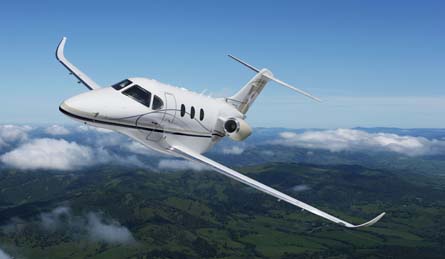The decision by Hawker Beechcraft (HBC) at the start of the month to "slow development" of its Hawker 200 light business jet is yet another indication of the dire market conditions at the lower end of the business jet spectrum.
Furthermore, the situation shows scant signs of improvement for the foreseeable future, as the financial crisis - now in its fourth year - tightens its grip on the world economy.
This is the second time the US-based airframer has been driven by the economic malaise to halt the development of its much-vaulted Hawker 200 - launched in 2008 as the Premier II.
 |
|---|
| HBC: set to slow development of its Hawker 200 |
The six-seat aircraft is an enhanced version of the Premier IA - currently in production - which is itself a revamp of the ten-year-old Premier 1. Service entry was originally planned for the first half of 2010, but a year after its unveiling HBC moved the delivery schedule back by almost three years.
Another of HBC's light jet stable - the Hawker 400XP - became a casualty of the financial crisis in 2010. Hit by poor sales and low demand, production of the six-seat aircraft was suspended.
While HBC has expressed a determination to bring both products back to market when the economic conditions improve, many industry observers do not foresee an uptick in demand at the lower end of the aircraft marketplace for at least another 18 months.
Some observers, meanwhile, questioned HBC's decision to postpone the Hawker 200 programme.
"It is an interesting move to 'suspend' or 'cancel' the Hawker 200, however you read it," said Flightglobal Ascend analyst Daniel Hall. "But I think it puts HBC in a very precarious position.
"While their key competitor [Kansas-based] Cessna is developing new aircraft types, HBC is focusing on its re-engined older aircraft - the Hawker 800XPr and the 400XPr, for example.
"HBC's top of the range Hawker 4000 also sits in the incredibly competitive super-midsize segment - set to become even more so when the Dassault Falcon 2000S arrives [next year]."
Hall's view is echoed by fellow aerospace analyst Richard Aboualfia, who pointed to the significance of the Hawker 200 for HBC's future. "This upgrade is essential to transform the Premier I design and keep it competitive against Cessna and Embraer products," he said. "With the bottom half of the market still quite depressed - and with money a pressing issue for Hawker - they're running out of room to manoeuvre.
"This move - and the layoffs [made by HBC over the past three years] - imply a very difficult situation."
HBC's struggles are a reflection of the listless light jet sector. Here, the economic malaise has decimated new aircraft orderbooks and brought the used aircraft sales market to its knees.
Brendan Lodge, business development director with international aircraft broker Jet Brokers, said the global inventory of used aircraft has reached a record level of about 14% - well above the historical average of 6%.
"While larger cabin, long-range types such as the Bombardier Global XRS [and] Gulfstream G550 are proving popular once again, smaller types such as the Learjet 45s, Cessna CJ1s and Premier Is are proving much harder to shift, and asking prices have fallen dramatically over the past four years," he said.
A Hawker 400XP purchased new in 2007 for $7.3 million is now worth $2.7 million. A Premier IA purchased at the same time for $6.2 million will now fetch just $2.9 million, Lodge conceded.
Added to this is the fact that the inventories of used entry-level and light cabin jets for sale is well above the historical average, he said.
"Of the 161 Premier 1A's in service, 22 of these aircraft - almost 15% of the fleet - are for sale. This represents almost two years worth of inventory, given that HBC has sold around 12 1A's this year. Until the used aircraft inventory shrinks significantly, sales of new aircraft will remain low," he said.
"Flat is the new growth in this sector", according to Andrew Hoy, managing director of business aviation services provider ExecuJet. He said: "I would be happy if the market were flat, but economic conditions are so volatile. Prices can be up one month and down the next."
Hoy said traditional buyers of light aircraft tend to be millionaires or companies, many of which offset some of the cost of owning and operating the aircraft by making it available for charter. "Unfortunately, given the sluggish state of the charter market, it is no longer able to feed the light jet buyers," he added.
Similarly, demand for entry-level and light jets has plummeted within their traditional markets of western Europe and North America. These regions have borne the brunt of the economic worries, and there is little demand or appetite here for private aircraft.
"Emerging markets such as Russia and China only want large aircraft, but there is some demand in Central and Latin America, particularly Brazil and Mexico," Hoy said.
Another key obstacle to growth within the light jet sector is the lack of available finance. "Light jets are the part of the market that most require third-party finance," Aboulafia said.
This view is supported by Lodge, who added: "Banks are nervous. They have tightened their lending criteria since the downturn struck. Many will not support loans on aircraft under $15 million and more than 15 years old, because they are viewed as more of a risk."
Source: Flight International



















